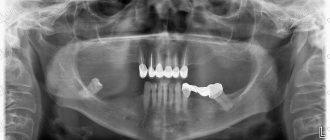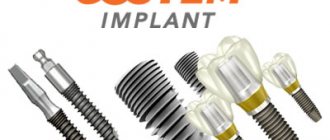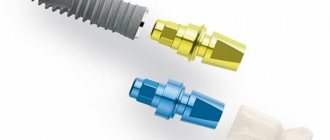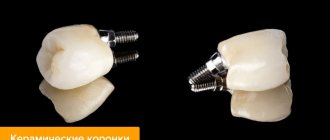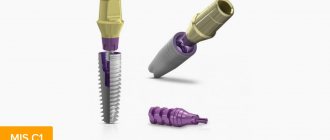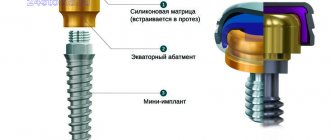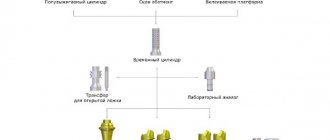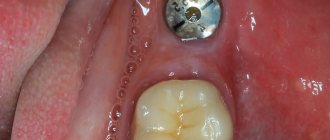The term “abutment” comes from the English word “abutment” (translated as “support” or “secondary part of the implant”). Indeed, the abutment
installed on
the implant
- and it functions as a link that connects it to the prosthesis. Despite the fact that abutments can be different, one end of them is screwed onto an already installed implant, and the other serves as a support on which the dentist places the prosthesis.
Although many implant manufacturers strive to produce one-piece designs in which the endosseous portion is integrated with the apex, avoiding the need for an abutment
, complete abandonment of them is not yet possible. It is thanks to them that maximum aesthetics is achieved, which makes them indispensable for dental prosthetics in the smile area.
Consultation with an orthopedist—RUB 1,000.
Individual abutment made of zirconium oxide - RUB 32,000.
At CELT you can get advice from a dental specialist.
- The cost of an orthopedic consultation is 1,000
Make an appointment
Types of abutments, their features
| Abutment type | Advantages | Flaws |
| Standard - is a design made in accordance with a template, available in different lengths and angles of the upper cone. |
|
|
| An individual abutment is made taking into account the anatomical characteristics of the patient in accordance with the three-dimensional model of his jaw. |
|
|
In addition, based on the design and application features, the following types of abutments for implants
:
| Type of design | Peculiarities |
| Globular | It has a round shape and is intended for mini-implantation using removable prostheses. Allows you to quickly and easily carry out prosthetics, but is not able to provide a uniform load on the implants and wears out quickly. |
| Angular | It has a design in which the head can be tilted from 15° to 45° in 10° increments. Designed for use with implants installed at an angle due to anatomical features. |
| Straight | It is considered the most practical and is widely used in cases where the entire structure has a straight line. As a rule, it is used to restore front teeth. |
| Whole | It is one piece with the implant. It is the best option for implantation under a one-stage protocol with immediate loading. |
| Temporary | It is a design for forming a beautiful gum relief around the implant and prosthesis. Installed during the implant healing period and removed after that. |
Types of abutments
Conventionally, all manufactured abutments can be divided into several categories, which differ in scope and technical characteristics. The table below shows all the current types of abutments.
Standard abutment
Universal designs made from templates. They can have different shapes, diameters and sizes.
- Suitable for most situations.
- Acceptable price.
- It's pretty easy to find a replacement.
- The individual characteristics of the anatomy of the dental system are not always taken into account.
- Soft tissue aesthetics are often limited.
- In some cases, the workmanship is not of the best quality.
Custom abutment
Individual abutments take into account the anatomical features (shape of teeth and gums, bite nuances) of a particular patient.
The production of an individual abutment implies the presence of a 3D model of the jaw, which eliminates the slightest errors and deviations. The most common are custom zirconium abutments (higher grade products) and custom titanium abutments.
- High quality workmanship, custom compatibility.
- The best indicators of functionality and aesthetics.
- Excellent fit to the gum line, due to which no additional manipulation of soft tissues is required.
- High price.
Angled abutment
Such abutments are also called multi-unit. They are installed on implants that were implanted at a non-standard angle due to the anatomical features of the jaw structure and dentition. The angular abutment, by changing the angle of inclination of the longitudinal axis, allows for an optimal combination of implant and crown.
Ball abutment
Round-shaped ball abutments are used for mini-implantation. Most often, a removable denture is installed on ball-shaped abutments.
Temporary abutment (abutment - gum former)
A temporary titanium abutment is a plug that is placed after implantation of an artificial root and helps to form the desired soft tissue relief around the installed implant and future orthopedic structure. The healing abutment is installed while the implant is healing and subsequently removed. Also considered temporary are plastic abutments, which are used quite rarely.
One-piece designs
The implant and abutment are one unit. Such designs are most often used for simultaneous implantation.
Manufacturing materials
In the process of studying the material about what implant abutments are, you will definitely come across information about the materials from which they are made. And this is no coincidence: the functionality and aesthetic result of further prosthetics depends on what material is used.
| Materials for production | Abutment Features |
| Plastic | They have the lowest price; due to their lack of strength, they are used as a temporary measure during the formation of gingival implants during the healing process. |
| Titanium | They have an optimal price-quality ratio, are durable and reliable, but cannot always be used to restore teeth in the smile area, since they are visible through the crown. |
| Ceramics | They are used if the patient suffers from individual intolerance to metal elements; they are ideal for restoring front teeth. |
| Zirconium dioxide | They are the most expensive, especially when made individually. Capable of providing a durable solution, very durable and aesthetically pleasing. |
| Combined (titanium-zirconium alloys) | Quite expensive, but they provide excellent restoration results: both in terms of functionality and aesthetics. |
Manufacturing of abutments - features of materials
There is a separate classification of abutments according to the type of materials from which they are made. Today, the material is of significant importance, since not only the functional, but also the aesthetic result comes to the fore.
Titanium
Titanium abutments are considered one of the most popular on the market. They are distinguished by strength, reliability and reasonable price. On the other hand, titanium abutments are not always suitable for esthetic restorations, as they can show through the crown.
Zirconium
Zirconium abutment is a modern and quite expensive solution for prosthetics. The highest cost is a custom abutment made of zirconium dioxide. These abutments combine strength and aesthetics.
Combined
It is usually an alloy of titanium and zirconium. They allow you to achieve good functional and aesthetic indicators, but at the same time they have a rather high cost and are not offered by all manufacturing companies.
Ceramic
A good option for those who are allergic to metal components. In addition, such abutments are used for aesthetic restorations in the frontal area.
Plastic
The cheapest plastic abutments designed for temporary restorations.
Features of abutment installation
The procedure for installing an abutment is quite complex, since it requires not only screwing it in, but also reliable fixation. If the abutment is not installed correctly, the crown will become loose and eventually fall out. In order to achieve the desired result, two types of fixation methods are used:
- Screw - requires making a small hole in the crown through which the abutment screw is passed. The crown is screwed on, after which the hole is masked with special materials and fixed. The risk of breaking the crown with such fixation is higher, but the risk of developing inflammatory processes is lower, and the fixation itself is quite reliable;
- Using dental cement - does not require drilling a hole in the prosthesis, fixation is carried out using cement. It is used in cases where screwing is not possible, since the risk of damage to the crown is high and the aesthetic characteristics deteriorate.
How does the installation work?
Poorly installed abutment can subsequently lead to loosening of the crown and its loss. Reliable fixation of this element can be carried out using cement mortar and the screw connection method. The first method of fastening differs in that the crown is glued to the implant based on a special cement liquid. Screw fixation involves screwing the prosthesis onto a connecting element; for this, a small hole is made in the crown, and then it is closed with a solution.
With two-stage implantation, the installation of the abutment is carried out at the second stage; in the case of a one-stage technology, this element is already connected to the implant.
Where to make?
If you need to undergo implantation and select an abutment in Moscow
, contact the multidisciplinary clinic CELT. The specialists of our dental department carry out individual selection of abutments, taking into account a number of aspects:
- the patient's wishes regarding appearance;
- thickness of the mucous membrane;
- type of prosthesis fixation;
- the gap between adjacent teeth and the head of the implant.
Thanks to a balanced assessment of all the above factors, the selection of the abutment is carried out correctly: it forms a clear gum line and is a reliable support for soft tissues. All this minimizes the possibility of cement penetration under the gum and ensures long-term results! Contact us!
Reviews of doctors providing the service - Abutment
I would like to express my gratitude to the dentist Elena Nikolaevna Kiseleva and her assistant Svetlana - they are real specialists and at the same time sensitive, not burnt out by years of practice.
Thanks to them, I have been coming back here for many years. Thanks to the management for such doctors! Read full review Svetlana Nikolaevna
13.08.2021
I am very grateful to Evgeniy Borisovich Antiukhin for removing my three eights. Especially considering that the lower tooth was not the simplest (it was located in an embrace with a nerve). The removal took place in 2 stages, one tooth under local anesthesia, two under general anesthesia. I had no idea that wisdom teeth could be... Read full review
Sofia
28.12.2020
Installing an abutment on an implant
The one-stage implantation technique involves installing an implant and abutment (most often it is a one-piece structure) in one visit to the doctor. If we consider the classic two-step technique, then the installation of the implant, abutment and crown is carried out in several steps:
- preliminary procedures before implantation (consultation, tests, photographs, etc.);
- surgical stage of implantation with installation of a temporary gum former;
- installation of abutment after implantation.
When installing the abutment directly, two types of fastening are used.
Abutment fixation
Cement fixation is carried out using a special cement-based material. A simple and aesthetic method, the disadvantages of which are difficulties in removing excess cement, as well as removing and replacing the prosthesis.
Screw fixation is the fastening of a prosthesis using a screw mechanism. A hole is made in the crown through which the abutment screw passes, after which the hole is closed with material and ground. This technique is safer from the point of view of inflammation, but the risk of structural failure is greater.
